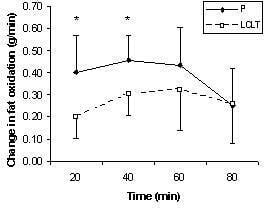The present study, which had ethics committee approval, examined the effect of 14 d supplementation of L-Carnitine L-tartrate (LCLT) on the metabolic response to exercise at different intensities and whether this was altered by the composition of prior dietary intake. Fifteen healthy, endurance trained males undertook this double-blind, placebo-controlled trial and were pair-matched on the basis of power output achieved at VO2max, age and body composition before random allocation to placebo (P, n=7) or treatment (LCLT, n=8). Treatment consisted of 2 capsules b.i.d. (3g LCLT/d) for 15 d. Subjects attended the laboratory on 3 occasions (baseline, day 14 and day 15), 3 h after a standardised meal. For 2 d prior to baseline and day 14, subjects consumed a prescribed diet (3158 ± 335 kCal/d 59% carbohydrate (CHO), 25% fat, 15% protein) and were asked to undertake the same exercise each time. Between days 14 and 15, subjects were provided with an isoenergetic high fat (HF) diet (3182 ± 215 kCal/d 15% CHO, 70% fat, 15% protein). Exercise trials consisted of an 80 min cycle ergometer ride with 20 min at each of 20, 40, 60 and 80% of VO2max incorporating indirect calorimetry and venous blood sampling. No difference in any blood metabolites or the estimated rate of CHO or fat oxidation was observed by RM ANOVA at any workload between groups at baseline (mean ± SD for first 60 min exercise: total CHO oxidation 120 ± 23 and 111 ± 30 g, total fat oxidation 26 ± 12 and 26 ± 14 g) or at day 14 (122 ± 30 and 103 ± 25 g, 21 ± 7 and 29 ± 11 g) for P and LCLT groups, respectively. The HF diet resulted in elevated resting plasma FFA (day 14 to HF trial: 0.11 ± 0.08 to 0.46 ± 0.12 and 0.35 ± 0.20 to 0.57 ± 0.30 mmol/L for P and LCLT, p<0.05); and an elevated plasma FFA and blood glycerol concentration, and increased fat and reduced CHO oxidation (fat: 47 ± 6 and 46 ± 8 g; CHO: 80 ± 12 and 69 ± 20 g for P and LCLT) during exercise. However, a greater change in the rate of fat oxidation was observed between days 14 and 15 with P than LCLT; significant at 20 and 40% workloads (p<0.02; Figure 1). The results indicate that 14 d supplementation with 3g LCLT/d does not alter the metabolic response to 20 min periods of exercise at 20, 40, 60 and 80% of VO2max. The underlying mechanism for the suppressed shift towards increased fat oxidation at low exercise intensities in the LCLT group following the HF diet may be due to differences in circulating FFA between the two groups.
King's College London (2005) J Physiol 565P, C42
Communications: Effect of L-Carnitine supplementation on exercise metabolism at different workloads and following a high fat preload in man.
Broad, E M; Maughan, R J; Galloway, S D R;
1. University of Stirling, Stirling, United Kingdom. 2. Loughborough University, Loughborough, United Kingdom.
View other abstracts by:
Figure 1. Change in fat oxidation rate during exercise between day 14 and day 15 trials (mean +/- SD). * Significant difference between P and LCLT p<0.02 (t test).
Where applicable, experiments conform with Society ethical requirements.

